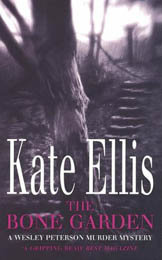
EURO CRIME
Reviews

Ellis, Kate - 'The Bone Garden'
Paperback: 320 pages (Jun. 2006) Publisher: Piatkus Books ISBN: 074993705X
Archaeologists excavating the grounds of Earlsacre Hall in Devon before the site is redeveloped as an arts centre discover a skeleton buried under an old sundial. The body seems to date from the early eighteenth century. Before too long, another body emerges beneath the second.
In a more topical plot development, Detective Sergeant Wesley Peterson and his colleagues in the Morbay police force are called to a local caravan park where a body has been found. Used to dealing with pettier crimes, the murder investigation proceeds at a rather leisurely pace, with some obvious leads (such as promptly interviewing the people in a photo in a newspaper article found with the body) being left unattended for days.
The old and new mysteries are linked by the friendship of Wesley and Neil Watson, one of the archaeologists, dating from their time together at university. Their friendship has featured in previous books, THE BONE GARDEN being the fifth in a series. I haven't read the earlier books, but it isn't necessary to have done so to enjoy this one.
As Neil and his colleagues, particularly the attractive but suspicious Claire, piece together the story of the skeletons (soon to become three) and how they came to be buried in the mansion's grounds, Wesley and his colleagues try to discover the identity of the man in the caravan park. Matters come to a head after a local cricket match, at which a local solicitor, Brian Willerby, who has tried and failed previously to contact Wesley about some unspecified worries, has finally arranged a meeting with the detective. By this time, Wesley has evidence implicating Willerby: but is he the murderer?
The strongest parts of THE BONE GARDEN are the characters of Wesley and his colleagues, whose camaraderie has an easy charm and whose domestic lives are nicely conveyed. The plot is pretty solid, though the mystery depends rather too much on the investigation happening in a particular order, and the breakthrough is triggered by coincidence when a man is arrested for a minor crime turns out to know crucial information relevant to the murder case.
Many of the characters at the archaeological site, in the town and at the cricket match turn out to be connected in a web of various deceits. Although the identity of the villain became obvious to me about 50 pages before it did to the police (there is a big hint in the prologue), I liked the way that Wesley's patient investigations of witnesses young and old, sympathetic and not so attractive, solidly builds the bricks in the wall of the solution.
The parallel historical mystery is well told. Although it is unlikely that the entire set of relevant documents providing the details would have been undiscovered and unspoilt after three hundred years, there is atmospheric suspense in the story of the effects of the Monmouth rebellion and the fate of the sympathisers at the infamous Judge Jeffries' Bloody Assizes. These historical events formed the background to R D Blackmore's classic LORNA DOONE, but here are given a poignant twist, unconsciously repeated by the present-day murderer.
Maxine Clarke, England
July 2007
Details of the author's other books with links to reviews can be found on the Books page.
More European crime fiction reviews can be found on the Reviews page.